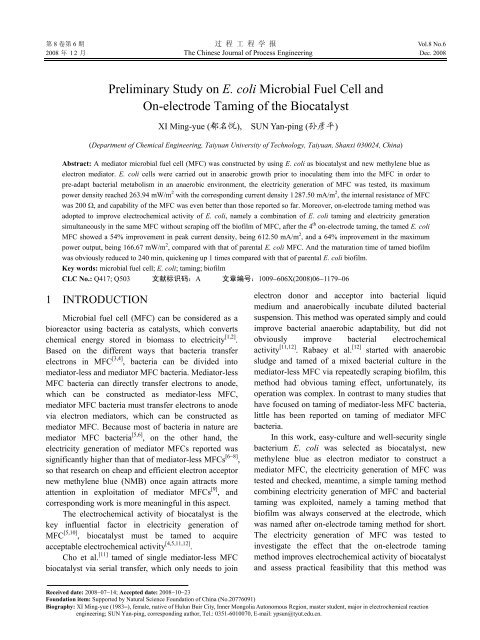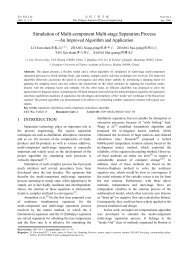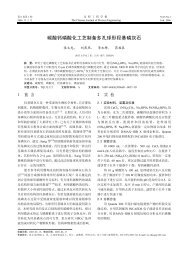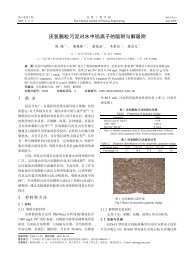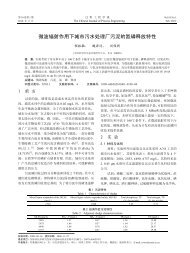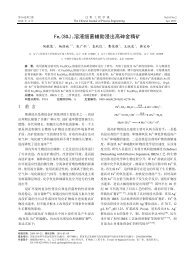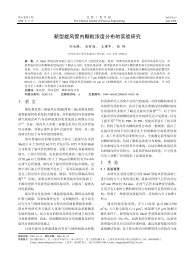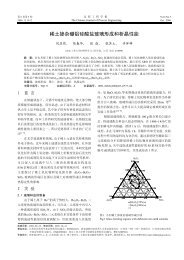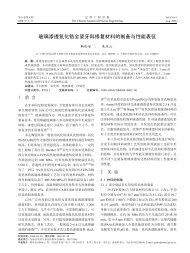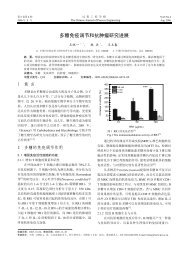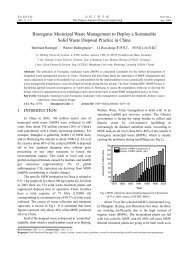Preliminary Study on E. coli Microbial Fuel Cell and On-electrode ...
Preliminary Study on E. coli Microbial Fuel Cell and On-electrode ...
Preliminary Study on E. coli Microbial Fuel Cell and On-electrode ...
- No tags were found...
You also want an ePaper? Increase the reach of your titles
YUMPU automatically turns print PDFs into web optimized ePapers that Google loves.
第 8 卷 第 6 期 过 程 工 程 学 报 Vol.8 No.62008 年 12 月 The Chinese Journal of Process Engineering Dec. 2008<str<strong>on</strong>g>Preliminary</str<strong>on</strong>g> <str<strong>on</strong>g>Study</str<strong>on</strong>g> <strong>on</strong> E. <strong>coli</strong> <strong>Microbial</strong> <strong>Fuel</strong> <strong>Cell</strong> <strong>and</strong><strong>On</strong>-<strong>electrode</strong> Taming of the BiocatalystXI Ming-yue ( 郗 名 悦 ), SUN Yan-ping ( 孙 彦 平 )(Department of Chemical Engineering, Taiyuan University of Technology, Taiyuan, Shanxi 030024, China)Abstract: A mediator microbial fuel cell (MFC) was c<strong>on</strong>structed by using E. <strong>coli</strong> as biocatalyst <strong>and</strong> new methylene blue aselectr<strong>on</strong> mediator. E. <strong>coli</strong> cells were carried out in anaerobic growth prior to inoculating them into the MFC in order topre-adapt bacterial metabolism in an anaerobic envir<strong>on</strong>ment, the electricity generati<strong>on</strong> of MFC was tested, its maximumpower density reached 263.94 mW/m 2 with the corresp<strong>on</strong>ding current density 1287.50 mA/m 2 , the internal resistance of MFCwas 200 Ω, <strong>and</strong> capability of the MFC was even better than those reported so far. Moreover, <strong>on</strong>-<strong>electrode</strong> taming method wasadopted to improve electrochemical activity of E. <strong>coli</strong>, namely a combinati<strong>on</strong> of E. <strong>coli</strong> taming <strong>and</strong> electricity generati<strong>on</strong>simultaneously in the same MFC without scraping off the biofilm of MFC, after the 4 th <strong>on</strong>-<strong>electrode</strong> taming, the tamed E. <strong>coli</strong>MFC showed a 54% improvement in peak current density, being 612.50 mA/m 2 , <strong>and</strong> a 64% improvement in the maximumpower output, being 166.67 mW/m 2 , compared with that of parental E. <strong>coli</strong> MFC. And the maturati<strong>on</strong> time of tamed biofilmwas obviously reduced to 240 min, quickening up 1 times compared with that of parental E. <strong>coli</strong> biofilm.Key words: microbial fuel cell; E. <strong>coli</strong>; taming; biofilmCLC No.: Q417; Q503 文 献 标 识 码 :A 文 章 编 号 :1009−606X(2008)06−1179−061 INTRODUCTION<strong>Microbial</strong> fuel cell (MFC) can be c<strong>on</strong>sidered as abioreactor using bacteria as catalysts, which c<strong>on</strong>vertschemical energy stored in biomass to electricity [1,2] .Based <strong>on</strong> the different ways that bacteria transferelectr<strong>on</strong>s in MFC [3,4] , bacteria can be divided intomediator-less <strong>and</strong> mediator MFC bacteria. Mediator-lessMFC bacteria can directly transfer electr<strong>on</strong>s to anode,which can be c<strong>on</strong>structed as mediator-less MFC,mediator MFC bacteria must transfer electr<strong>on</strong>s to anodevia electr<strong>on</strong> mediators, which can be c<strong>on</strong>structed asmediator MFC. Because most of bacteria in nature aremediator MFC bacteria [5,6] , <strong>on</strong> the other h<strong>and</strong>, theelectricity generati<strong>on</strong> of mediator MFCs reported wassignificantly higher than that of mediator-less MFCs [6−8] ,so that research <strong>on</strong> cheap <strong>and</strong> efficient electr<strong>on</strong> acceptornew methylene blue (NMB) <strong>on</strong>ce again attracts moreattenti<strong>on</strong> in exploitati<strong>on</strong> of mediator MFCs [9] , <strong>and</strong>corresp<strong>on</strong>ding work is more meaningful in this aspect.The electrochemical activity of biocatalyst is thekey influential factor in electricity generati<strong>on</strong> ofMFC [5,10] , biocatalyst must be tamed to acquireacceptable electrochemical activity [4,5,11,12] .Cho et al. [11] tamed of single mediator-less MFCbiocatalyst via serial transfer, which <strong>on</strong>ly needs to joinelectr<strong>on</strong> d<strong>on</strong>or <strong>and</strong> acceptor into bacterial liquidmedium <strong>and</strong> anaerobically incubate diluted bacterialsuspensi<strong>on</strong>. This method was operated simply <strong>and</strong> couldimprove bacterial anaerobic adaptability, but did notobviously improve bacterial electrochemicalactivity [11,12] . Rabaey et al. [12] started with anaerobicsludge <strong>and</strong> tamed of a mixed bacterial culture in themediator-less MFC via repeatedly scraping biofilm, thismethod had obvious taming effect, unfortunately, itsoperati<strong>on</strong> was complex. In c<strong>on</strong>trast to many studies thathave focused <strong>on</strong> taming of mediator-less MFC bacteria,little has been reported <strong>on</strong> taming of mediator MFCbacteria.In this work, easy-culture <strong>and</strong> well-security singlebacterium E. <strong>coli</strong> was selected as biocatalyst, newmethylene blue as electr<strong>on</strong> mediator to c<strong>on</strong>struct amediator MFC, the electricity generati<strong>on</strong> of MFC wastested <strong>and</strong> checked, meantime, a simple taming methodcombining electricity generati<strong>on</strong> of MFC <strong>and</strong> bacterialtaming was exploited, namely a taming method thatbiofilm was always c<strong>on</strong>served at the <strong>electrode</strong>, whichwas named after <strong>on</strong>-<strong>electrode</strong> taming method for short.The electricity generati<strong>on</strong> of MFC was tested toinvestigate the effect that the <strong>on</strong>-<strong>electrode</strong> tamingmethod improves electrochemical activity of biocatalyst<strong>and</strong> assess practical feasibility that this method wasReceived date: 2008−07−14; Accepted date: 2008−10−23Foundati<strong>on</strong> item: Supported by Natural Science Foundati<strong>on</strong> of China (No.20776091)Biography: XI Ming-yue (1983−), female, native of Hulun Buir City, Inner M<strong>on</strong>golia Aut<strong>on</strong>omous Regi<strong>on</strong>, master student, major in electrochemical reacti<strong>on</strong>engineering; SUN Yan-ping, corresp<strong>on</strong>ding author, Tel.: 0351-6010070, E-mail: ypsun@tyut.edu.cn.
1180 过 程 工 程 学 报 第 8 卷applied to industrializati<strong>on</strong>.2 EXPERIMENTAL2.1 E. <strong>coli</strong> <strong>and</strong> Culture C<strong>on</strong>diti<strong>on</strong>sE. <strong>coli</strong> 1.0487 was obtained from the ChinaGeneral Microbiological Culture Collecti<strong>on</strong> Center(CGMCC).Aerobic growth of E. <strong>coli</strong> cells was carried out insterilized Luria–Bertani (LB) medium (10 g/L glucose,10 g/L pept<strong>on</strong>e, 5 g/L yeast, 10 g/L NaCl, <strong>and</strong> pH=7). E.<strong>coli</strong> cells were inoculated into the liquid medium, thengrew at 30℃ in a c<strong>on</strong>stant temperature incubator. After24 h, the E. <strong>coli</strong> cells were carried out the anaerobicgrowth prior to inoculating them into the MFC topre-adapt bacterial metabolism in an anaerobicenvir<strong>on</strong>ment, <strong>and</strong> electrochemical activity of E. <strong>coli</strong> wasfurther improved to some extent. The LB medium wasc<strong>on</strong>tinually aerated with N 2 for 30 min to remove O 2 ,finally vitamin C <strong>and</strong> olefin were added to insurecompletely anaerobic c<strong>on</strong>diti<strong>on</strong>s in culture process. theE. <strong>coli</strong> cells were incubated for 24 h at 30℃.2.2 MFC SystemNafi<strong>on</strong>112 membrane. It was obtained fromAmerican Du P<strong>on</strong>t Company. Before use, the membranewas boiled in 3% H 2 O 2 for 1 h, then treated with 80℃dei<strong>on</strong>ized water <strong>and</strong> 0.5 mol/L H 2 SO 4 , again treatedwith 80℃ dei<strong>on</strong>ized water twice, <strong>and</strong> finally kept indei<strong>on</strong>ized water [9] .Carb<strong>on</strong> paper. It was obtained from TorayCorporati<strong>on</strong>, Japan. New <strong>electrode</strong>s were soaked in 1mol/L HCl soluti<strong>on</strong> for 1 d to remove possible metalc<strong>on</strong>taminati<strong>on</strong>. After each use, the <strong>electrode</strong>s werewashed with 1 mol/L NaOH soluti<strong>on</strong> to treat theattached cells [13] .MFC. A dual-chambered cell was c<strong>on</strong>structed,using 4.0 cm 2 carb<strong>on</strong> paper as the anode, 1.0 cm 2platinum gauze (50 mesh) as the cathode. C<strong>on</strong>necti<strong>on</strong>swere made with copper wire screwed into holes drilleddirectly into the <strong>electrode</strong>s (the hole c<strong>on</strong>nected the wire<strong>and</strong> the carb<strong>on</strong> paper was sealed with epoxy resin toavoid corrosi<strong>on</strong> of copper wire [7,9] ). The chambers wereseparated with a Nafi<strong>on</strong>112 membrane. Each chamberhad 60 mL volume in dimensi<strong>on</strong>s of 3 cm×4 cm×5 cm,the exposure area of membrane was 1.0 cm 2 . Prior to theinoculati<strong>on</strong> of E. <strong>coli</strong> cells, N 2 was aerated into theanode chamber to remove O 2 in the medium, whichguaranteed the strict anoxic c<strong>on</strong>diti<strong>on</strong>s [9] .Electrolyte. The anode soluti<strong>on</strong> c<strong>on</strong>tains LBmedium, buffer soluti<strong>on</strong>s (10 g/L NaHCO 3 <strong>and</strong> 8.5 g/LNaH 2 PO 4 ), electr<strong>on</strong> mediator (1.5 g/L NMB) with thepH value at 7. The cathode soluti<strong>on</strong> c<strong>on</strong>tains 1 mol/LK 3 Fe(CN) 6 , 0.1 mol/L phosphate buffer, <strong>and</strong> 10 g/LNaCl with the pH value at 7 [14−16] .35 mL fresh anode soluti<strong>on</strong> was added in the anodechamber of sterilized MFC (UV light: 256 nm,overnight), then N 2 was aerated for 30 min, <strong>and</strong> finallyvitamin C <strong>and</strong> olefin were added to insure completelyanaerobic c<strong>on</strong>diti<strong>on</strong>s. 40 mL catholyte was added intothe cathode chamber. 5 mL E. <strong>coli</strong> cell suspensi<strong>on</strong>anaerobically cultured were rapidly inoculated into theanode chamber,then the electrochemical test of MFCwas carried out at 30℃.2.3 Methods2.3.1 Open circuit voltage (OCV)After 5 mL E. <strong>coli</strong> cell suspensi<strong>on</strong> was added intothe MFC, the relati<strong>on</strong>ship of OCV of MFC with timewas tested until the OCV had been stable for 30 min.2.3.2 Polarizati<strong>on</strong> curve of MFCAfter the OCV was stable, the resistance betweenthe <strong>electrode</strong>s was lowered stepwise, pausing at eachresistance setting for about 3∼5 min [17,18] , current (I, mA)<strong>and</strong> voltage (U, V) were recorded at each resistance,Power (P) was calculated according to P=IV. Current<strong>and</strong> power were normalized by the cross-secti<strong>on</strong>al area(projected) of the anode.2.3.3 Peak current densityThe relati<strong>on</strong>ship between current density of theMFC with time was tested under a fixed load of 1000Ω. During the growth of E. <strong>coli</strong> cells, the currentdensity of MFC would gradually rise, <strong>and</strong> finallyreached a peak current density, namely the biofilmattached to the <strong>electrode</strong> had matured [3,6,19,20] .3 RESULTS AND DISCUSSION3.1 Working Mechanism of MFCTaking glucose as the fuel, E. <strong>coli</strong> metabolizedglucose, then released electr<strong>on</strong> <strong>and</strong> prot<strong>on</strong>, electr<strong>on</strong> wastransferred to anode by mediator (NMB), then tocathode by external circuit, meantime, prot<strong>on</strong> moved tocathode chamber through prot<strong>on</strong> exchange membrane,then at the cathode it combined with electr<strong>on</strong> <strong>and</strong>oxygen to form water. The detailed transfer process isshown in Fig.1 (Switches 1 <strong>and</strong> 2 were off when thecircuit was open, switch 1 was <strong>on</strong> <strong>and</strong> switch 2 off whenthe circuit was closed, <strong>and</strong> switch 1 was off <strong>and</strong> switch2 <strong>on</strong> when a circuit with external variable resistance wasused). The related reacti<strong>on</strong>s are expressed in Eqs.(1~4).Glucose is completely oxidized to CO 2 <strong>on</strong> anode:C 6 H 12 O 6 +6H 2 O ⎯ E. ⎯→<strong>coli</strong> ⎯ 6CO +24H + +24e − . (1)2
第 6 期 XI Ming-yue, et al.: <str<strong>on</strong>g>Preliminary</str<strong>on</strong>g> <str<strong>on</strong>g>Study</str<strong>on</strong>g> <strong>on</strong> E. <strong>coli</strong> <strong>Microbial</strong> <strong>Fuel</strong> <strong>Cell</strong> <strong>and</strong> <strong>On</strong>-<strong>electrode</strong> Taming of the Biocatalyst 1181In the cathod chamber, [Fe(CN) 6 ] 3− is reduced to[Fe(CN) 4 ] 2− , then [Fe(CN) 4 ] 2− oxidized to [Fe(CN) 6 ] 3− :4[Fe(CN) 6 ] 3− +4e −4[Fe(CN) 6 ] 4− +4H + +O 2The MFC reacti<strong>on</strong> is expressed as:C 6 H 12 O 6 +6O 2⎯→4[Fe(CN) 6 ] 4− , (2)Pt⎯⎯→ 4[Fe(CN) 6 ] 3− +2H 2 O. (3)⎯→6CO 2 +6H 2 O. (4)shown in Fig.3. Al<strong>on</strong>g with the outer resistanceincreasing, the power output first increased thendecreased, there was a maximum value of power output,being 263.94 mW/m 2 , based <strong>on</strong> the ohm law, the outerresistance is equal to the inner resistance when poweroutput attains the maximum, so we can know that theinner resistance of MFC in this work was about 200 Ω.250Power density (mW/m 2 )200150100500 2000 4000 6000 8000 10000Resistance (Ω)Fig.1 Illustrati<strong>on</strong> of the MFC3.2 Electrochemical Measurement3.2.1 OCV test of MFCFigure 2 shows the open circuit voltage of MFCover time. After E. <strong>coli</strong> cells were inoculated into theanode soluti<strong>on</strong>, the stable time of MFC′s OCV needed65 min, <strong>and</strong> the value was 0.598 V. Zou et al. [9] reporteda parental E. <strong>coli</strong> MFC, its stable time was 300 min,which is much higher than that of the present work.Open circuit voltage (V)0.600.580.560.540.520.500.480.460.440.4220 40 60 80 100 120 140Time (min)Fig.2 Open circuit voltage of the MFC with time3.2.2 Polarizati<strong>on</strong> curve of MFCWhen the OCV of MFC attained the plateau phase,the resistance (0∼10000 Ω) between the <strong>electrode</strong>s waslowered stepwise to select proper outer resistance forbenefiting the power output of MFC. The relati<strong>on</strong>shipbetween resistance <strong>and</strong> power density for the MFC isFig.3 Relati<strong>on</strong>ship between power density <strong>and</strong>resistance of microbial fuel cellFigure 4 shows the cell voltage <strong>and</strong> power outputdensity in the MFC as a functi<strong>on</strong> of current density.When the outer resistance decreased, then the currentdensity increased gradually <strong>and</strong> the cell voltagedecreased gradually, the maximum power density ofMFC was 263.94 mW/m 2 with the corresp<strong>on</strong>dingcurrent density of 1287.50 mA/m 2 .<strong>Cell</strong> voltage (V)0.452500.400.352000.301500.250.201000.15500.100 200 400 600 800 1000120014001600Current density (mA/m 2 )Fig.4 <strong>Cell</strong> voltage <strong>and</strong> power output density inthe MFC as a functi<strong>on</strong> of current densityThe capabilities of MFC in this work (stable time,current density, <strong>and</strong> power output) were even better thanthose reported in the literature so far for E. <strong>coli</strong>MFCs [9,16] . The reas<strong>on</strong> was because of less innerresistance of the MFC [18,21] . Additi<strong>on</strong>ally, in theexperimental process, E. <strong>coli</strong> cells were carried outunder anaerobic growth prior to inoculating them intoPower output density (mW/m 2 )
1182 过 程 工 程 学 报 第 8 卷the MFC, anaerobic experiments with E. <strong>coli</strong> cells wereinitiated in order to pre-adapt bacterial metabolism in ananaerobic envir<strong>on</strong>ment, then E. <strong>coli</strong>′s electrochemicalactivity was improved to some extent. So MFC couldrapidly generate electricity <strong>and</strong> attain stable state.3.2 <strong>On</strong>-<strong>electrode</strong> Taming MethodsBiofilm attached to <strong>electrode</strong> is developed asfollows: bacterial attachment to <strong>electrode</strong>, earlymaturati<strong>on</strong> <strong>and</strong> acquisiti<strong>on</strong> of biofilm structure, maturebiofilm, <strong>and</strong> bacterial detachment [22] . The electricitygenerati<strong>on</strong> of MFC is extremely related to the formedmature biofilm attached to the <strong>electrode</strong> [6,19,20] . However,most of MFC bacterial taming methods usually needrepeatedly scrap biofilm to select <strong>and</strong> optimize bacteria,but the operati<strong>on</strong> of scraping biofilm can result in theloss of electrochemical activity of biofilm <strong>and</strong>postp<strong>on</strong>ing the time that biofilm again matures.<strong>On</strong>-<strong>electrode</strong> taming method judges the maturati<strong>on</strong> ofbiofilm according to the voltage−ampere curve of MFC,which means that the current density of MFC justattains the plateau phase (reaching the peak currentdensity) when the biofilm has matured [3,6,19,20] , theoperati<strong>on</strong>s of <strong>on</strong>-<strong>electrode</strong> taming without scraping offof biofilm can simply <strong>and</strong> rapidly achieve the bacterialselecti<strong>on</strong> <strong>and</strong> optimizati<strong>on</strong>.During the experiments, when the MFC attainedthe plateau of current density for the first time, thebiofilm attached to carb<strong>on</strong> paper had matured, <strong>and</strong> theelectrochemically activated E. <strong>coli</strong> biomass wasaccumulated, meantime, the anode soluti<strong>on</strong> wasremoved out to eliminate the infecti<strong>on</strong> of accumulatedoutgrowth <strong>and</strong> detached cells in the anode chamber afterthe MFC run for a l<strong>on</strong>g time [6,8] , <strong>and</strong> the anode chamberwas rapidly added with 40 mL medium to anaerobicallyculture the mature E. <strong>coli</strong> biofilm attached to the<strong>electrode</strong>, <strong>and</strong> the electrochemical activity of E. <strong>coli</strong>biofilm was c<strong>on</strong>served. When MFC was again addedwith anolyte to carry out the electrochemical test, itspeak current density was increased, <strong>and</strong> the time toreach the peak current value was reduced. Successiveanaerobic cultivati<strong>on</strong> <strong>and</strong> electrochemical test werecarried out to tame of E. <strong>coli</strong> biofilm <strong>and</strong> graduallyimprove the electrochemical activity of E. <strong>coli</strong> biofilm.As shown in Fig.5, after the 4 th taming (n=4), themaximum current density of E. <strong>coli</strong> MFC <strong>and</strong> theparental (n=0) E. <strong>coli</strong> MFC was respectively 612.5 <strong>and</strong>397.5 mA/m 2 , namely the biofilms attached to the<strong>electrode</strong>s had matured. We can see from theexperimental data that the maturati<strong>on</strong> time of tamedbiofilm was obviously reduced to 240 min, quickeningup 1 times compared with that of parental E. <strong>coli</strong>,meantime, the maximum current density of the tamed E.<strong>coli</strong> MFC was increased 0.54 times compared with thatof parental E. <strong>coli</strong> MFC.Current density (mA/m 2 )400650390 (a) Before taming600(b) After the 4th taming380370550360500350450340400330350320200 250 300 350 400 450 500 550300200 250 300 350 400 450 500Time (min)Time (min)Fig.5 Relati<strong>on</strong>ship between current density <strong>and</strong> time in MFCs before <strong>and</strong> after taming of E. <strong>coli</strong>Figure 6 shows the relati<strong>on</strong>ship of cell voltage <strong>and</strong>power density with current density of MFC in thetaming process under n=0, 2, 4. After the 4 th<strong>on</strong>-<strong>electrode</strong> taming (n=4), the maximum power densityof tamed E. <strong>coli</strong> MFC reached 166.67 mW/m 2 ,increasing 64% compared with the maximum powerdensity 101.81 mW/m 2 of the parental E. <strong>coli</strong> MFC(n=0).As summarized in Fig.7, after the 4 th <strong>on</strong>-<strong>electrode</strong>taming, the electricity generati<strong>on</strong> of tamed E. <strong>coli</strong> MFCwas remarkably improved compared with the electricityCurret density (mA/m 2 )generati<strong>on</strong> of parental E. <strong>coli</strong> MFC, the tamed E. <strong>coli</strong>MFC showed a 54% improvement in peak currentdensity, reaching 612.50 mA/m 2 , a 64% improvement inmaximum power output, reaching166.67 mW/m 2 . Zou etal. [9] reported a parental E. <strong>coli</strong> MFC, its maximum poweroutput was 70% of that of the MFC in this work, being116 mW/m 2 , <strong>and</strong> the initial c<strong>on</strong>centrati<strong>on</strong> of E. <strong>coli</strong> inthe literature was 220% of that in this work, being 2.73mg/mL.Because taming of mediator MFC bacteria byserial transfer was not reported in the literature, in the
第 6 期 XI Ming-yue, et al.: <str<strong>on</strong>g>Preliminary</str<strong>on</strong>g> <str<strong>on</strong>g>Study</str<strong>on</strong>g> <strong>on</strong> E. <strong>coli</strong> <strong>Microbial</strong> <strong>Fuel</strong> <strong>Cell</strong> <strong>and</strong> <strong>On</strong>-<strong>electrode</strong> Taming of the Biocatalyst 1183<strong>Cell</strong> voltage (V)0.451800.401600.351400.30120n0.250 1000.2028040.15600.10400.05200.000 300 600 900 1200 1500 1800Power density (mW/m 2 )Peak current density (mA/m 2 )6005505004504000 2 4 6170160150140130120110100Maximum power density (mW/m) 2 )Current density (mA/m 2 )Taming timesFig.6 Relati<strong>on</strong>ships of current density with voltage<strong>and</strong> power density in taming processesFig.7 Relati<strong>on</strong>ships of taming times with the maximumcurrent <strong>and</strong> power densitypresent experiments, we ever attempted to adopt theoperating steps of literature [11] to tame E. <strong>coli</strong>. Theelectr<strong>on</strong> mediator NMB was added for taming ofmediator MFC bacteria, however, plenty of black-greendepositi<strong>on</strong> was found in diluent, which led to theremarkable fluctuati<strong>on</strong> of experimental data. Whether ornot this method can be adopted for taming of mediatorMFC bacteria still needs more research.Owing to benefiting envir<strong>on</strong>mental protecti<strong>on</strong>,electricity generati<strong>on</strong> with sludge <strong>and</strong> sewage hasimportant significance to development of MFC. Rabaeyet al. [12] tamed of a mixed bacterial culture in themediator-less MFC via repeatedly scraping biofilm, butthis method had tamed for 7 times <strong>and</strong> 63 d. The<strong>on</strong>-<strong>electrode</strong> taming method reported in this work hasno special requirement to the types of bacteria <strong>and</strong> doesnot need to scrap off biofilm, so the advantages ofsimple operati<strong>on</strong> <strong>and</strong> short time make <strong>on</strong>-<strong>electrode</strong>taming method a highly promising c<strong>and</strong>idate forapplicati<strong>on</strong> in microbially aggressive envir<strong>on</strong>ments likesewage or sludge.4 CONCLUSIONS(1) A mediator microbial fuel cell (MFC) wasc<strong>on</strong>structed with E. <strong>coli</strong> in this work. The capabilities ofthe MFC were even better than those reported in theliterature so far for E. <strong>coli</strong> MFCs. E. <strong>coli</strong> cells werecarried out in anaerobic growth prior to inoculatingthem into the MFC in order to pre–adapt bacterialmetabolism in an anaerobic envir<strong>on</strong>ment, the anaerobicgrowth operates simply, <strong>and</strong> may apply to improveelectrochemical activity of all kinds of MFCbiocatalysts. The electricity generati<strong>on</strong> of E. <strong>coli</strong> MFCis characterized with the following data: when the initialc<strong>on</strong>centrati<strong>on</strong> of E. <strong>coli</strong> cells was 3.41 mg/mL, themaximum power density of MFC reached 263.94mW/m 2 with the corresp<strong>on</strong>ding current density of1287.50 mA/m 2 . The internal resistance of MFC was200 Ω.(2) After the 4 th <strong>on</strong>-<strong>electrode</strong> taming, the electricitygenerati<strong>on</strong> of tamed E. <strong>coli</strong> MFC was compared withthe electricity generati<strong>on</strong> of parental E. <strong>coli</strong> MFC whenthe initial c<strong>on</strong>centrati<strong>on</strong> of E. <strong>coli</strong> cells was 1.24 mg/mL,the tamed E. <strong>coli</strong> MFC showed a 54% improvement inpeak current density, being 612.50 mA/m 2 ; a 64%improvement in maximum power output, reaching166.67 mW/m 2 . In the meantime, the maturati<strong>on</strong> time oftamed biofilm was obviously reduced to 240 min,quickening 1 times compared with that of parental E.<strong>coli</strong> biofilm. The <strong>on</strong>-<strong>electrode</strong> taming method describedhere does not need to scrap off biofilm, <strong>and</strong> has theobvious advantages of the less taming times <strong>and</strong> shortertaming time.REFERENCES:[1] Kim J R, Jung S H, Regan J M, et al. Electricity Generati<strong>on</strong> <strong>and</strong><strong>Microbial</strong> Community Analysis of Alcohol Powered <strong>Microbial</strong> <strong>Fuel</strong><strong>Cell</strong>s [J]. Bioresour. Technol., 2007, 98(13): 2568−2577.[2] Frank D, S′eamus P J Higs<strong>on</strong>. Biofuel <strong>Cell</strong>s—Recent Advances <strong>and</strong>Applicati<strong>on</strong>s [J]. Biosens. Bioelectr<strong>on</strong>., 2007, 22(7): 1224−1235.[3] Lovley D R. <strong>Microbial</strong> <strong>Fuel</strong> <strong>Cell</strong>: Novel <strong>Microbial</strong> Physiologies <strong>and</strong>Engineering Approaches [J]. Curr. Opin. Biotechnol., 2006, 17(3):327–332.[4] K<strong>on</strong>g X Y, Li L H, Sun Y M, et al. Fundamental <str<strong>on</strong>g>Study</str<strong>on</strong>g> <strong>on</strong> <strong>Microbial</strong><strong>Fuel</strong> <strong>Cell</strong> <strong>and</strong> Influent Factors <strong>on</strong> Output Power [J]. Modern Chem.Ind., 2007, 27(2): 282−286 (in Chinese).[5] H<strong>on</strong>g Y G, Guo J, Sun G P. Recent Progress in Electricigens <strong>and</strong><strong>Microbial</strong> <strong>Fuel</strong> <strong>Cell</strong> [J]. Acta Microbiologica Sinica, 2007, 47(1):173−177 (in Chinese).[6] Lian J, Feng Y L, Li H R, et al. C<strong>on</strong>structi<strong>on</strong> <strong>and</strong> <str<strong>on</strong>g>Preliminary</str<strong>on</strong>g> Studies<strong>on</strong> the Direct <strong>Microbial</strong> <strong>Fuel</strong> <strong>Cell</strong> [J]. The Chinese Journal of ProcessEngineering, 2006, 6(3): 408−412 (in Chinese).[7] Kim H J, Park H S, Hyun M S, et al. A Mediator-less <strong>Microbial</strong> <strong>Fuel</strong><strong>Cell</strong> Using a Metal Reducing Bacterium, Shewanella utrefacien [J].Enzyme Microb. Technol., 2002, 30(2): 145–152.[8] Park D H, Zeikus J G. Electricity Generati<strong>on</strong> in <strong>Microbial</strong> <strong>Fuel</strong> <strong>Cell</strong>sUsing Neutral Red as an Electr<strong>on</strong>ophore [J]. Appl. Envir<strong>on</strong>.
1184 过 程 工 程 学 报 第 8 卷Microbiol., 2000, 66(4): 1292–1297.[9] Zou Y J, Sun L X, XU F, et al. E. <strong>coli</strong> <strong>Microbial</strong> <strong>Fuel</strong> <strong>Cell</strong> Using NewMethylene Blue as Electr<strong>on</strong> Mediator [J]. Chemical Journal ofChinese Universities, 2007, 28(3): 510−513 (in Chinese).[10] Logan B E, Regan J M. Electricity-producing Bacterial Communitiesin <strong>Microbial</strong> <strong>Fuel</strong> <strong>Cell</strong> [J]. Trends Microbiol., 2006, 14(12): 512−518.[11] Cho E J, Ellingt<strong>on</strong> A D. Optimizati<strong>on</strong> of the Biological Comp<strong>on</strong>entof a Bioelectrochemical <strong>Cell</strong> [J]. Bioelectrochemistry, 2007, 70(1):165–172.[12] Rabaey K, Bo<strong>on</strong> N, Siciliano S D, et al. Biofuel <strong>Cell</strong>s Select for<strong>Microbial</strong> C<strong>on</strong>sortia that Self-mediate Electr<strong>on</strong> Transfer [J]. Appl.Envir<strong>on</strong>. Microbiol., 2004, 70(9): 5373–5382.[13] Liu Z D, Li H R. Effects of Bio- <strong>and</strong> Abio-factors <strong>on</strong> ElectricityProducti<strong>on</strong> in a Mediatorless <strong>Microbial</strong> <strong>Fuel</strong> <strong>Cell</strong> [J]. Biochem. Eng.J., 2007, 36(3): 209−214.[14] Wang Y F, Cheng S S, Tsujimura S, et al. Escherichia <strong>coli</strong>-catalyzedBioelectrochemical Oxidati<strong>on</strong> of Acetate in the Presence ofMediators [J]. Bioelectrochemistry, 2006, 69: 74–81.[15] Zhang T, Zeng Y L, Chen S L, et al. Improved Performances of E.<strong>coli</strong>-catalyzed <strong>Microbial</strong> <strong>Fuel</strong> <strong>Cell</strong>s with Composite Graphite/PTFEAnodes [J]. Electrochem. Commun., 2007, 9(3): 349–353.[16] Qiao Y, Li C M, Bao S J, et al. Carb<strong>on</strong> Nanotube/PolyanilineComposite as Anode Material for <strong>Microbial</strong> <strong>Fuel</strong> <strong>Cell</strong>s [J]. J. PowerSources, 2007, 170(1): 79−84.[17] Zhang E R, Xu W, Diao G W, et al. Electricity Generati<strong>on</strong> fromAcetate <strong>and</strong> Glucose by Sedimentary Bacterium Attached toElectrode in <strong>Microbial</strong>-anode <strong>Fuel</strong> <strong>Cell</strong>s [J]. J. Power Sources, 2006,161(2): 820–825.[18] Liang P, Fan M Z, Cao X X, et al. Compositi<strong>on</strong> <strong>and</strong> Measurement ofthe Apparent Internal Resistance in <strong>Microbial</strong> <strong>Fuel</strong> <strong>Cell</strong> [J].Envir<strong>on</strong>ment Science, 2007, 28(8): 1894−1898 (in Chinese).[19] Cress<strong>on</strong> R, Carrere H, Delgenes J P, et al. Biofilm Formati<strong>on</strong> duringthe Start-up Period of an Anaerobic Biofilm Reactor—Impact ofNutrient Complementati<strong>on</strong> [J]. Biochem. Eng. J., 2006, 30(1): 55−62.[20] Picioreanu C, Head I M, Katuri K P, et al. A Computati<strong>on</strong>al Modelfor Biofilm-based <strong>Microbial</strong> <strong>Fuel</strong> <strong>Cell</strong>s [J]. Water Res., 2007, 41(3):2921−2940.[21] Liu Z D, Lian J, Du Z W, et al. C<strong>on</strong>structi<strong>on</strong> of Sugar-based<strong>Microbial</strong> <strong>Fuel</strong> <strong>Cell</strong>s by Dissimilatory Metal Reducti<strong>on</strong> Bacteria [J].Chin. J. Biotechnol., 2006, 22(7): 131−137 (in Chinese).[22] Ghigo J M. Are There Biofilm-specific Physiological Pathwaysbey<strong>on</strong>d a Reas<strong>on</strong>able Doubt? [J] Res. Microbiol., 2003, 154(1): 1−8.


